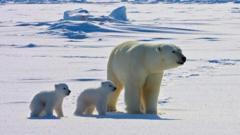Recent research indicates that polar bears in the Chukchi Sea, situated between Alaska and Russia, are experiencing heightened health risks as warming temperatures diminish sea ice, crucial for their survival. Scientists analyzed blood samples collected over three decades, comparing data from 1987-1994 to 2008-2017. Alarmingly, the study found an increased presence of viruses, bacteria, and parasites in more recent samples, indicating changing health dynamics among this vulnerable species.
Wildlife biologist Dr. Karyn Rode from the US Geological Survey stated that these shifts can be attributed to extensive sea ice loss and increased terrestrial human activity. "We wanted to know if exposure to certain land-associated pathogens had changed," she explained. The increase included two types of parasites linked to conditions like toxoplasmosis and neosporosis, as well as illnesses such as rabbit fever and canine distemper.
Typically resilient to disease, polar bears are not known for significant population declines due to illnesses, but Dr. Rode's findings suggest that the entire Arctic ecosystem is undergoing transformation. The dwindling sea ice—a vital hunting platform—is forcing these magnificent bears onto land, where their access to prey is severely limited, resulting in nutritional deficiencies. As polar bears grapple with these changes, their exposure to pathogens through land-based prey species might be shifting significantly.
With only about 26,000 polar bears remaining globally, primarily residing in Canada, they are classified as vulnerable by the International Union for Conservation of Nature, with climate change being a pivotal factor. The study's insights, published in PLOS One, highlight the urgent need for conservation efforts focused on maintaining polar bear habitats and mitigating the impacts of climate change. As these apex predators experience the consequences of a warming world, the need for comprehensive environmental stewardship has never been more critical.





















